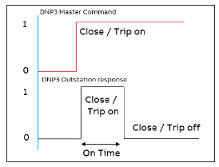Binary output refers to the command sent from a master to an outstation to change the state of output point. A common method named Control Relay Output Block (CROB) is used for binary output control in DNP3, specifying actions like turning on, off, or pulse operations.
Control model (Close and Trip): there are 3 control modes which gives the status of binary output for control model.
-
Activation mode
-
Complementary latch model
-
Complementary two-output model.
-
Activation mode: The activation model has a single virtual or physical output. The purpose of this type of output is to initiate an action (i.e., “cause it to happen”). This model set output to pulse generation for set ontime, offtime and counts.
For example: Pulse ON Command - On time 1s, Off time 1s and Count 2.

For example: Pulse OFF Command - On time 1s, Off time 1s and Count 2.

-
Complementary latch model: A complementary latch model has a single virtual or physical output that remains latched in an active or non-active state depending on which command is received. This model set output to continuous ON or OFF mode as per command.
For example: Latch ON / Latch OFF Command

-
Complementary two-output model: A complementary, two-output model has two virtual or physical outputs, named close and trip at a single index. This model set one or the other output active momentarily depending on which command is received.
For example: Close command - On time 1s.

Operating mode:
There are two modes.
-
Remote mode: Value 0
The operating condition where the outputs will be controlled by the master which is located remotely.
-
Local mode: Value 1
The operating condition where the outputs are operated locally at the device where the mapping points are physically located.
Event variation:
-
Status without time – binary output events are reported without timestamp, master logs the events with timestamp at which it received the event
-
Status with time – binary output events are reported with timestamp from outstation. master will log the event with outstation supplied timestamp.
Static variation:
-
Packed format – it reports the current value of a binary output state without status flag.
-
Output status with flags – it reports the current value of a binary output state with status quality flag.





